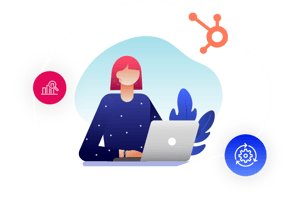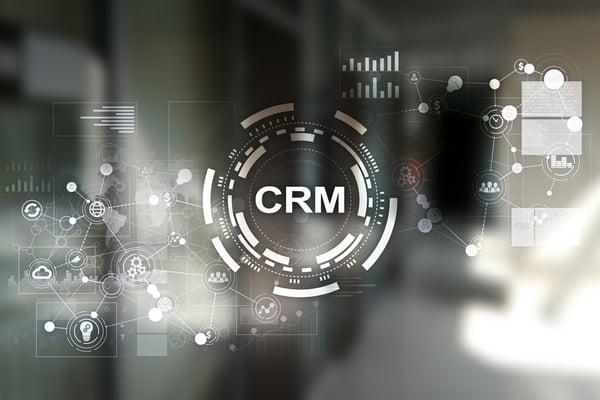5 Signs It's Time for a HubSpot Integration
CRM Integration 05/31/2022 • 4 min read • Written by Megan Combs
Peace and harmony: It’s how we want everything in the world to exist, right? We all know this isn’t always the case, but we’re here to tell you that it can happen in your workplace.
If you’re working in an environment where you have to log in to different systems to find data, and you’re wondering whether that data is even accurate, you’re not working in peace and harmony — you’re working in chaos!
These are just two of the signs that it may be time for a HubSpot integration. We’ll get into those and three others below and help you get back to feeling zen.
5 Signs It’s Time for a HubSpot Integration
If doing daily tasks feels like a chore because of all the hoops you have to jump through, it’s time to consider springing for a HubSpot integration. When your sales and marketing teams align, you’ll hit the mark every time.
Here are five signs it’s time for a HubSpot integration.
1. Your employees are logging data in two different systems
If your employees are constantly having to log in and out of different systems to find what they’re looking for, they’re going to be frustrated and they’re going to disengage. Who can blame them?
Integrations with HubSpot can end your dealings with disparate systems and
house everything under one roof.
2. You're lacking a single source of truth
If data is unorganized and stored in several different places, you’re lacking a single source of truth (SSOT). How would anyone know if the data they found is up to date and aligns with today’s business decisions? A single

source of truth ensures that everyone in an organization makes business decisions using the same data.
Using a central CRM as your SSOT will make it easier to make data-driven business decisions.
3. You're doubting if your data is accurate or not
The first two signs above culminate here. With disparate systems and a lacking SSOT, who even knows what data is accurate anymore? This is bad news for business. First off, it’s impossible to make those data-driven business decisions. Second, you may irritate your customers if you’re reaching out with bad information.
For example, say John has already purchased your product. If you reach out with an email with the top five reasons he should buy your product, he’s probably going to be frustrated and send it straight to the trash. He’s already been through this stage. Now he’s looking for more educational materials on how your product works and how it can make his life easier.
4. User adoption is lacking
If your teams have had a bad experience with finding data, or data being wrong and/or unorganized, you’re going to have a hard time with user adoption. Is it even worth their time and effort to log the data?
When you integrate your systems with one CRM, it makes training so much easier and less cumbersome. If everyone is using the same system and they have a good user experience, you’ll witness better employee buy-in.
5. You’re missing opportunities to connect
When your data is all over the place, you’re going to miss opportunities to connect with leads. When all of your data is aligned, it’s easier to find where your customers are in their buyer journey and reach out to them with personalized messages such as “Hey Megan, we saw you bought a new [product]. You would probably also like [this product accessory]!”
This would also work for event data: “Hey Megan, we saw you attended our event in Chicago last year. We'll be in Chicago again next month — come check it out!”
Types of Integrations You Can Use
Convinced it’s time for an integration or two? Here are a couple of places to find what you need.
HubSpot App Marketplace: The HubSpot App Marketplace has thousands of integrations built by HubSpot and its partners to keep your systems aligned. Data Sync allows you to connect HubSpot with the rest of your tech stack. It’s code-free and allows for two-way historical syncing, uniting all of your customer data in one place.
It can power integrations with Microsoft 365, Zendesk, MailChimp, Intercom and more.

SyncSmart Integrations: If you can’t find what you’re looking for in the HubSpot App Marketplace, SyncSmart can help. SyncSmart offers a variety of integrations that go beyond the capabilities of HubSpot’s Data Sync. Most of SyncSmart’s integrations are bi-directional, which means you can close the loop on any reporting gaps. A packaged integration from SyncSmart allows you to download the integration you need, choose your syncing requirements, and get back in business.
Use HubSpot Integrations to Improve Workflows
If you’re ready to get back in the groove of doing business with data you can trust, find the integration that’s right for you. Start by checking out the app marketplace or SyncSmart, and reach out if you still need help getting started.
By: Megan Combs
With a background in magazine journalism, Megan channels her love of the English language and grammar into her writing and editing. Before joining Lynton, Megan was a top content marketer at a digital marketing agency, where she helped clients translate their brand promises into strategic digital and social media messages.
You May Also Like

CRM Integration
Out-of-the-Box Integrations vs. Custom Integrations
Do you need an out-of-the-box or custom integration? Discover what's involved in each and how your company should choose betw...
Keep Reading
CRM Integration
Get More Value Out of Your CRM Integration
An integration can be a complex project with a fluctuating timeline. These steps will ensure you get the most out of your Hub...
Keep Reading
HubSpot
Use HubSpot Workflows to Boost Your Marketing Automation: Part 1
Get started with HubSpot workflows to automate mundane daily tasks so you can focus on what matters — boosting your bottom li...
Keep ReadingSubscribe Today
